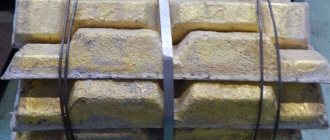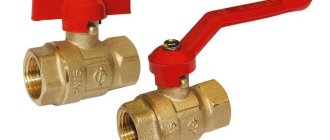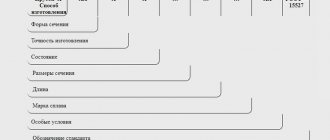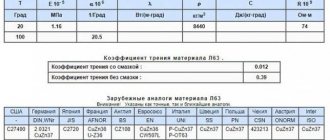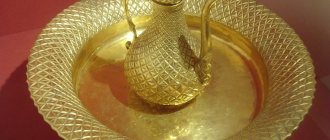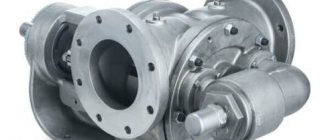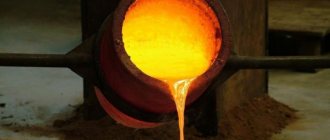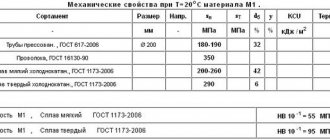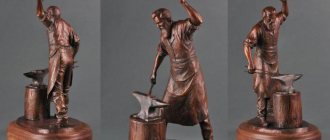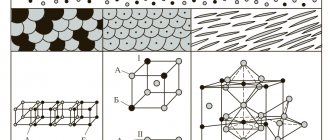INTERSTATE STANDARD
PRESSURE TREATED
Stamps
INTERSTATE COUNCIL FOR STANDARDIZATION, METROLOGY AND CERTIFICATION Minsk
Preface
1 DEVELOPED by the Russian Federation, Interstate Technical Committee for Standardization MTK 106 “Tsvetmetprokat”
2 INTRODUCED by Gosstandart of Russia
ADOPTED by the Interstate Council for Standardization, Metrology and Certification (Minutes No. 17 of April 1, 2004, by correspondence)
| State name | Name of the national standardization body |
| Azerbaijan | Azstandard |
| Armgosstandard | |
| Belarus | State Standard of the Republic of Belarus |
| Kazakhstan | Gosstandart of the Republic of Kazakhstan |
| Republic of Kyrgyzstan | Kyrgyzstandard |
| The Republic of Moldova | Moldovastandard |
| Russian Federation | Gosstandart of Russia |
| The Republic of Tajikistan | Tajikstandard |
| Turkmenistan | Main State Service "Turkmenstandartlary" |
| Uzbekistan | Uzstandard |
| Gospotrebstandart of Ukraine |
3 By Order of the Federal Agency for Technical Regulation and Metrology dated October 25, 2004 No. 42-st, the interstate standard GOST 15527-2004 was put into effect directly as a national standard of the Russian Federation on July 1, 2005.
COPPER-ZINC ALLOYS (BRASS), PRESSURE TREATABLE
Stamps
Pressure treated copper zinc alloys (brasses). Grades
Date of introduction 2005-07-01
Physical properties
The phase state of the LS59-1 alloy is determined by a small amount of substance in the b-phase, while lead is present as an independent phase, which explains its good machinability. This is the main property of lead brasses. High-speed processing of alloy workpieces occurs with little tool wear. During the process, small loose chips are formed, which ensures the cleanliness of the surface being processed and a slight hardening during cutting. Due to its good machinability, alloy LS59-1 is used for the production of small-sized parts for ultra-precision mechanics.
LS59-1 has low impact strength and low bending strength with an existing notch. The alloy is a good structural material even at low temperatures. Plasticity is maintained at lower temperatures down to helium temperatures. At average temperatures (200-600°C) the alloy exhibits the phenomenon of brittleness due to the multiphase structure of the material. Impact strength decreases with increasing temperature. The material may crack, so the alloy is not suitable for forging. Brass LS59-1 has good strength and corrosion resistance to various environments. The alloy has good anti-friction properties. It can be used in the production of small parts that are designed to operate under high friction (for example, plain bearings). The electrical and thermal conductivity of LS59-1 is less than that of copper.
The high hardness of the alloy and its abrasion resistance make it possible to use sheet blanks for the production of guide elements for various machine tools. In terms of tensile strength, brass LS59-1 is inferior to alloy L63. The high hardness of cold-worked alloy sheets with good wear resistance determines their use for machine guides.
Brass loose grade - Metalworker's Guide
02.01.2018
The number of types of bronzes is huge. The metal, invented thousands of years ago, is used today in various fields of production. Some brands combine unique qualities and are sometimes simply irreplaceable. What kind of material this is will be discussed in the article.
Brass LS59-1: characteristics and composition of the alloy, GOST
Brass LS59-1 is a multicomponent copper alloy, the chemical composition of which is specified by GOST 15527-2004. This GOST indicates that such an alloy may contain 57–60% copper, 37.05–42.2% zinc and 0.8–1.9% lead. Other chemical elements present in the LS59-1 alloy as impurities may be contained in it in an amount of no more than 0.75%.
Brass ingots brand L59-1 are intended for subsequent processing
Although the alloy of this brand belongs to the category of brass, which is well processed by pressure, most often products made from it are processed on high-speed metal-cutting machines. Because of this, LS59-1 is also classified as an automatic weapon. The characteristics of brass of this brand are determined by lead, which is included in its composition as an alloying element.
You can familiarize yourself with the GOST requirements for brass alloys by downloading the document in pdf format from the link below. GOST 15527-2004 Copper-zinc (brass) alloys processed by pressure. Stamps Download
Corrosion resistance
After workpieces made from LS59-1 alloy are processed, the material does not experience significant stress. Since lead forms a separate phase, the alloy has good resistance to seasonal cracking, which can occur when the temperature and humidity of the environment increase. In terms of corrosion resistance, brass LS59-1 is superior to L63.
Under normal conditions, LS59-1 brass is stable in the following environments: sea and fresh water, air, including sea air, dry halogen gases, dry steam at low speeds, freons, alcohols and antifreezes. Relative resistance to corrosion is observed in alkalis without stirring.
Limitations on the corrosion resistance of the alloy are observed upon contact with fatty and mineral acids, oxidizing solutions, chlorides and hydrogen sulfide, in mine waters, as well as at high pressure in humid and saturated vapors. When LS59-1 brass comes into contact with aluminum, iron and zinc, accelerated destruction of the alloy (contact corrosion) will occur.
Application
Due to its high hardness, low cost, excellent machine machinability, corrosion resistance and anti-friction properties, LS59-1 brass is successfully used in all types of production. Various workpieces are mass produced from the alloy. It is used to produce: bushings, gears, forgings, wheels, pipes, fasteners. This is due to good machinability on machines. The parts of the machine tools themselves are also made from the alloy. They do not deform or wear out during operation.
Almost all types of rolled products are made from LS59-1 brass: LS59-1 plate, LS59-1 wire, LS59-1 circle, LS59-1 sheet, LS59-1 rod.
Cheap pipe blanks are made from the LS59-1 alloy using the continuous casting method, the cost of which is significantly lower than extruded ones. Pressed, semi-solid and hard rods are also mass produced from the alloy. Cold-worked sheets of LS59-1 are one of the most popular types of rolled brass. They are used in machine tool industry. Sheets are also produced from the alloy in hard, semi-hard and soft states. From rods made from LS59-1 brass, various small and large parts with good anti-friction properties are produced at minimal cost. The most popular are hexagonal and square rods.
Automatic multi-component brass LS59-1 has a chemical composition in accordance with GOST 15527. LS59-1 consists of 57-60% copper, 37.05-42.2% zinc, 0.8-1.9 lead and up to 0.75% impurities . Along with alloy L63, LS59-1 has found the most widespread use among pressure-processed brasses. According to the classification, our multicomponent alloy is a pressure-processable alloy, but in practice it is used more often as a free-form alloy. Both of these materials have the same thermal and electrical conductivity, but alloying the LS59-1 alloy with lead allows it to be used as a machine tool and more efficiently processed by cutting, producing small chips.
Brass grades - alloy composition, characteristics and application
- Brass. Composition, properties, brands of brass.
- Brass LS59-1: explanation, characteristics, composition, GOST
- Marking of brass and bronze.
- composition, color, density and other characteristics of the alloy
- PROPERTIES OF BRASS
- Brand – brass – Great Encyclopedia of Oil and Gas, article, page 1
- Brass, percentage composition
Brass is a copper-zinc alloy .
It can be double or multi-component. The color of brass depends on the percentage of zinc. Based on this, red brass is distinguished, i.e. tompak, which contains from 5 to 20% zinc, and semi-tompak, that is, yellow brass, containing up to 36% zinc. Sometimes the zinc content in brass reaches more than 45%. The higher the zinc content in the alloy, the cheaper its cost, and the technological, mechanical and antifriction properties of the alloy increase.
Brass has lower thermal and electrical conductivity compared to copper, and the anti-corrosion qualities of brass are somewhere in the middle between the characteristics of the original alloy components. Alloys containing more than 20% zinc have the disadvantage of being prone to cracking under storage conditions with high humidity. The presence of ammonia and sulfur dioxide gases enhances this effect.
To eliminate this drawback, low-temperature annealing is used after technological deformation. Strengthening of brass is carried out using strain hardening. An exception is the LANKMts 75-2-2.5-0.5-0.5 alloy, which is hardened by hardening and aging.
The phase composition of the alloy is an important feature of simple brasses. If the alloy contains up to 39% zinc, then it is a single-phase solid solution (a-phase), and when the zinc content is more than 39%, a second phase (b-phase) is formed. This alloy is hard and brittle, which means that two-phase alloys are stronger but less ductile than single-phase alloys.
Multicomponent brasses are alloys that are additionally alloyed with elements other than zinc. They are named after alloying additives: lead, aluminum, etc.
Markings for simple and multi-component brasses differ. The marking of simple brass contains the letter L and a number that indicates the percentage of copper.
The marking of multi-component brass also begins with the letter L, then the initial letters of the names of the alloying elements, an indication of the copper content as a percentage, and after a dash the percentage of alloying components.
Brasses are used for the manufacture of small parts, since these alloys are well shaped and processed, and also have fluidity and are susceptible to plastic deformation.
Brass is easy to weld and solder. The exception is lead brass.
Copper-zinc alloys can be processed in two ways and, depending on the technological processing, are divided into casting and wrought. Foundry brasses are intended for the production of shaped castings, and wrought brasses are intended for the production of rods, wire, tapes, pipes, sheets and strips.
Due to the presence of additional alloying elements in alloys, brass acquires specific properties. To increase corrosion resistance, nickel, tin, and aluminum are added to the alloy. And manganese increases the heat resistance of brass.
With the help of silicon, anti-corrosion properties, strength and anti-friction qualities are improved. To improve the machinability of brass on automatic machines, lead is added.
To prevent zinc from being washed out of brass in aggressive fresh waters, arsenic is added.
Depending on the condition of the material, rolled brass is divided into soft, semi-hard, hard and especially hard. The condition of the material depends on the grade of the alloy and the purpose of the rolled product. Rolled brass is produced in the form of pipes, wire, tapes, strips and sheets.
stroyrubrika.ru
Brass LS59-1: explanation, characteristics, composition, GOST
Brass LS59-1 is a multicomponent copper alloy, the chemical composition of which is specified by GOST 15527-2004. This GOST indicates that such an alloy may contain 57–60% copper, 37.05–42.2% zinc and 0.8–1.9% lead. Other chemical elements present in the LS59-1 alloy as impurities may be contained in it in an amount of no more than 0.75%.
Brass ingots brand L59-1 are intended for subsequent processing
Although the alloy of this brand belongs to the category of brass, which is well processed by pressure, most often products made from it are processed on high-speed metal-cutting machines. Because of this, LS59-1 is also classified as an automatic weapon. The characteristics of brass of this brand are determined by lead, which is included in its composition as an alloying element.
You can familiarize yourself with the GOST requirements for brass alloys by downloading the document in pdf format from the link below.
GOST 15527-2004 Copper-zinc (brass) alloys processed by pressure. StampsDownload
Mechanical characteristics
Due to the presence of lead in the composition of LS59-1 brass, when processing products made from it by cutting, small chips are formed, which allows such processing to be performed at high speeds.
A distinctive feature of the alloy in question is that lead constitutes a separate phase in its internal structure. This makes such a material highly susceptible to plastic deformation.
Meanwhile, if we compare LS59-1 brass with two-component alloys, it is significantly inferior to them in its ductility, so it is better to process such material by cutting.
The range of products made from LS59-1 brass includes:
- rods with different cross-section profiles;
- sheet material – strips, sheets, plates;
- wire;
- profile rolled products;
- pipe products.
Main characteristics of L59-1 brass
Brass of the LS59-1 brand is distinguished by good anti-friction characteristics, which allows the use of such material for the manufacture of products operated in conditions of high friction.
From this alloy, in particular, sliding bearings are produced, used to complete various mechanisms and machines.
In addition, the abrasion resistance that LS59-1 is characterized by allows this brass to be used for the manufacture of guides for machine tools for various purposes.
Technological properties of alloy L59-1
Since brass of this brand has a multiphase structure, products made from it are characterized by increased fragility.
Parts made from LS59-1, on which surface cuts are made, cannot be used as load-bearing elements, since they can break under significant pressure.
In addition, the increased fragility of this brass leads to the fact that when exposed to shock loads, the surface of products made of this material can become covered with cracks, which does not allow them to be processed using such a technological operation as forging.
Corrosion resistance
Due to the presence of lead in the chemical composition of brass of the brand in question, a separate phase is formed in its internal structure, which has a positive effect not only on its workability, but also on its resistance to corrosion.
Compared to other brass alloys, LS59-1 is more resistant to corrosion. Products made from such brass are not subject to cracking and oxidation when used in conditions of high humidity and temperature changes.
However, there is no need to talk about the exceptionally high corrosion resistance of LS59-1: in this parameter, this alloy is similar to brasses of other brands. In particular, it is not recommended to use it in cases where it will come into contact with products made of iron, aluminum and zinc. In addition, the corrosion resistance of LS59-1 will be poor when:
- simultaneous exposure to high humidity and high pressure;
- contact with fatty acids;
- operation in hydrogen sulfide environment;
- contact with ore waters and mineral acids;
- constant interaction with oxidized solutions and chlorides.
The characteristics of brass allow the metal to be used for the production of shut-off and connecting valves operated at temperatures above 100 degrees
LS59-1 demonstrates its corrosion resistance well under the following operating conditions:
- atmospheric air, including that saturated with sea salt vapor;
- dry steam;
- liquid medium characterized by a very low content of salts and acids;
- freon, alcohol solutions and antifreeze;
- salty sea water in a sedentary state.
It should be borne in mind that the interaction of LS59-1 brass with a gaseous or liquid medium characterized by a high content of ammonia, oxygen and carbon dioxide has a very negative effect on the corrosion resistance of the alloy.
Rental products
Various rolled metal products are manufactured from the brass of the brand in question, the requirements for the chemical composition and mechanical characteristics of which are specified by GOST 15527-2004. The range and parameters of the latter are regulated by other regulatory documents.
Pipes for the manufacture of which this alloy is used can be produced either by plastic deformation or by continuous casting.
At the same time, the production of pipes from brass LS59-1 by casting is much cheaper than the production of similar products obtained using deformation processes.
Brass pipe is easy to install by welding or soldering
The plastic deformation method for brass of this grade is used in the production of wire and rods, which can have a round, hexagonal or square cross-section. In this case, the manufacturing material itself must also meet the requirements established by GOST 15527-2004 (for products that are made from it, the standards are specified by GOST 1066).
Sheets are produced from LS59-1 brass, characterized by high density, hardness and, accordingly, wear resistance. Due to their characteristics, they are successfully used in the manufacture of guide machines for various purposes.
In addition, special technologies make it possible to produce soft, semi-hard and hard sheet materials from such brass. In this case, both the density and specific gravity of such products will correspond to similar parameters of the source material.
Brass sheets are used to make plumbing and electrical products, cladding panels and signs
Rods with different cross-sectional shapes made from LS59-1 brass are very actively used in industry. Their distinctive features are high strength and good machinability.
It is also important that the production of such products (for this purpose, rolling or drawing technology can be used) is characterized by low cost.
Depending on the manufacturing technology and scope of use, rods made of LS59-1 brass can be produced in soft, semi-hard or hard versions.
Mechanical properties of L59-1 brass rods
Areas of use
The wide range of applications of products made from LS59-1 brass is explained by such characteristics as:
- low cost;
- high hardness and strength;
- good machinability;
- wear resistance and corrosion resistance.
All this allows this alloy to be successfully used for manufacturing:
- elements of gear and worm connections;
- bushings and liners for various purposes;
- fastening elements;
- pipe products.
Article rating:
Mechanical properties of alloy LS59-1
The phase state of the alloy has a small amount of substance in the b-phase, and lead is a separate phase in it, so it can be easily processed by pressure and cutting. However, the ductility of LS59-1 is significantly inferior to two-component alloys and is recommended for cutting. It produces:
- tapes, strips and sheets of brass,
- profiles,
This alloy has anti-friction properties and can be used in the manufacture of small parts designed to operate under high friction, for example, plain bearings. Since it has a higher hardness than simple alloys and is resistant to abrasion, sheet blanks from it can be used for the manufacture of guide elements of various machine tools. You can buy LS59-1 brass in the appropriate section.
The problem with all multicomponent brasses is excessive fragility, which manifests itself under special conditions due to the multiphase structure of the material. In the material we are considering, lead forms a separate phase, which has a positive effect on the machinability of parts made from it on machines, but also makes the material more fragile. Parts made of LS59-1 with notches tend to break under high pressure, so they cannot be used as load-bearing elements. And with a high impact load on L63 workpieces, the material may become cracked due to its low impact toughness, so it is not suitable for forging.
Brass L63 and LS59. Difference between brands, application, characteristics. Rods, sheets. GOST standards
The most commonly used brasses: LS59-1 in the form of round, square and hexagonal bars, L63 in the form of strips, sheets, plates and wires, tubes. Sheets LS59-1 are used if processing on a milling machine or engraving is needed. If the sheet needs to be bent, then only grade L63 is soft.
Sheets and slabs made from the L63 brand are cheaper than from the LS59-1 brand. For rods, it’s exactly the opposite: L63 brass, which is less processed, costs about 20% more. This is due to the fact that L63 is made from pure copper scrap, and LS59-1 from scrap containing lead.
In the case of sheets, the increased cost of LS59-1 brass is associated with manufacturing difficulties. L63 brass is more viscous and there is less waste in the production of sheets. Cutting of brass sheets produced by our factories for processing non-ferrous metals is 600 x 1500 mm, i.e.
This is 0.9 square meters in one standard sheet of brass.
Brass sheets should be stored in a warm warehouse, since when the temperature changes and condensation gets on the sheets, the corrosion process begins. The brass darkens and white spots appear. Store brass sheets standing in cells.
Sometimes the question arises of how to distinguish brass from bronze BrAZh9-4, because they are similar in color. Bronze is magnetic, brass usually is not (the exception is brass containing iron, but they are weaker magnetic).
Brass has a higher density of 8.5 g/cm3 (in bronze BrAZh9-4 it is 7.6 g/cm3), therefore, with the same diameter and length, a brass rod weighs more. If brass is heated to a temperature of 600-650.C (dark red heat), the surface of the brass becomes covered with a thin ashy coating of zinc oxide .
This kind of deposit does not form on bronze. Bronze gives off a pink tint, while brass is yellow or even greenish-yellow.
You can distinguish L63 and LS59-1 brass from each other by scratching the rod. Brass LS59-1 creaks when scratched!
You can test brass for lead content : this is usually done like this: apply a drop of 9% vinegar to the sample, wait a while, then apply a drop of potassium iodide (available in pharmacies, chemical stores, in old military first aid kits as an anti-radiation agent), the appearance of a yellow color indicates the presence of lead. So it's lead brass.
Brass differs from bronze in its higher ductility and, accordingly, lower strength and wear resistance , which limits the use of this alloy in many areas.
In addition, brass is less resistant to aggressive environments, in particular salty sea water, which does not allow the use of brass products in shipbuilding, where bronze is used very actively and successfully.
The exception is tin brass grades LO.
There is also a noticeable difference in the color of these alloys and in their internal structure.
Any experienced specialist can tell you how to distinguish brass from bronze: to do this, just look at the fracture of products made from these alloys.
Brass has a lighter color when fractured and a distinct fine-grained structure, while bronze is easily identified by its dark brown fracture color and coarse-grained internal structure.
Sheet L63, if cut with a hacksaw, produces a burr, but LS-59 has practically no burr. Brand L63 brass is not suitable for engraving and milling.
No matter how much you select the modes, the cutters still break, the material is very viscous... When polishing, a sheet of L63 “floats” a lot. True, bending it is better than loose material, which can crack.
Brass brand LS59-1 is excellent for processing on automatic lathes, as the lead contained in the alloy makes the chips brittle and they do not wrap around the cutter.
By the way, the volume of produced brass LS59-1 is several times greater than the volume of production of all other brands of brass combined.
You can read about changing the color of brass (oxidation) here
The entire range of products made from brass L 63 and LS59
, stipulates
GOST 15527-70
(new edition -
GOST 15527
-
2004
)
“Copper-zinc (brass) alloys processed by pressure.
Brands" Brass rods were previously manufactured according to GOST 2060-90, in 2006 this GOST was updated to GOST 2060-2006 Brass rods. Technical conditions.
However, in the same year 2006, a new GOST
52597-2006
BRASS RODS FOR PROCESSING ON AUTOMATIC MACHINES was developed and introduced.
It regulates the production of rods from lead brass (automatic brass) grades LS63-3, LS59-1, LS59-1V, LS58-2, LS58-3, LS59-2 and LZhS58-1-1 with a diameter from 3 mm to 50 mm.
In fact, since 2006, the domestic non-ferrous metallurgy has been producing all lead brass in accordance with this GOST. According to the old GOST 2060, lead-free brass and pressed lead brass over a diameter of 50 mm are produced.
However, designers still have the Soviet GOST listed in old reference books, which is why difficulties periodically arise with the supplied brass of the LS59-1 brand.
Suppliers require that they provide certificates of manufacture before 2006.
Brass sheets are manufactured according to the Soviet GOST 931-90 (ST SEV 957-89) BRASS SHEETS AND STRIPS TECHNICAL CONDITIONS.
And although this GOST states that it is possible to produce sheets up to 1000 mm wide and up to 2000 mm long, alas, our industry only makes cuttings 600x1500 mm.
We cut brass sheets 1000x2000 mm and remain a legend.
In the food industry, it is better to use two-component brass of the L63 (L68) brand, since it does not contain lead, which has a harmful effect on living organisms.
processing of brass LS59-1. The shavings fall into small crumbs, hence the common name for brass “loose”
Brass kettle made of brass L68
Comparison of properties of L63 and LS59-1 (from here)
Practice shows that many consumers do not know what the differences are between the two most common brands of brass - LS59-1 and L63. Therefore, here are the answers to the most frequently asked questions.
- The electrical conductivity and thermal conductivity of these brasses are the same.
- These brasses differ from each other not because they have different copper contents, but because lead is present . Thanks to lead, LS59-1 sharpens perfectly with the formation of small loose chips.
- L63 is processed worse by cutting than LS59-1....it has different chips.
- In comparable conditions, rods made from LS59-1 are not much harder and stronger than L63. However, if there are notches, rods made of LS59-1 are easily subject to brittle fracture under lateral load. The impact strength of LS59-1 (5-6) is much less than that of L63 (14). For these reasons, under certain operating conditions, parts made from L63 may be more reliable than those from LS59-1.
- L63 is easily processed by cold pressure. The difference in ductility is clearly illustrated by a simple experiment: wire from L63 is easily flattened, and wire from LS59-1 cracks after 2-3 blows with a hammer. This distinguishes L63 from LS59-1 and determines the use of L63 for the manufacture of parts that require, in addition to turning and milling, additional forming by pressure.
- High ductility allows the use of L63 wire for the manufacture of rivets.
- L63 rods and wire are used as solder.
- LS59-1 has good antifriction properties and can be used in plain bearings operating at low specific pressures and high speeds.
- Cold-formed sheets made of LS59-1 have high hardness. combined with high wear resistance, this allows them to be used as guides in machine tools.
Materials for plain bearings
Properties of LS59-1
Mechanical properties differ for different semi-finished products due to the production method of LS59-1 brass.
Mechanical properties of LS59-1 at T=20oC
| Assortment | sв — Short-term strength limit | d5 — Elongation at break |
| MPa | % | |
| Pressed pipes, GOST 494-90 | 390 | |
| Pressed rod, GOST 2060-2006 | 360 | 22 |
| Solid rod, GOST 31366-2008 | 490 | 7 |
| Soft rod, GOST 31366-2008 | 330 | 25 |
| Soft wire, GOST 1066-90 | 340 | 25-30 |
| Solid wire, GOST 1066-90 | 440-640 | 1-8 |
| Cold-rolled hard strip, GOST 931-90 | 460-610 | 5 |
| Cold rolled soft strip, GOST 931-90 | 340-470 | 25 |
| Hot rolled strip, GOST 931-90 | 360-490 | 18 |
In reality, brass rod LS59-1 is produced semi-solid according to automatic GOST. Brass wire LS59-1 is produced both hard and soft; unlike rods, it can often be replaced with L63 brass.
Fur properties of brass rods LS59-1
| Preparation method | Delivery status of bars | Diameter, key number or square side, mm | Tensile strength σв, MPa (kgf/mm2) | Elongation after break % δ5 | Elongation after break % δ10 | Hardness NV - according to Brinell | Hardness HV - Vickers |
| soft rods | From 3 to 50 mm | 330 (34) | 25 | 22 | 80 | 80 | |
| Semi-solid | From 3 to 12 mm | 410 (42) | 10 | 8 | 100 | 121 | |
| Pulled | Semi-solid | From 13 to 20 mm | 390 (40) | 15 | 12 | 100 | 121 |
| Semi-solid | From 21 to 40 mm | 390 (40) | 18 | 15 | 100 | 121 | |
| Solid bars | From 3 to 12 mm | 490 (50) | 7 | 5 | 130 | 171 | |
| Pressed | From 10 to 50 mm | 360 (37) | 22 | 18 | — | 80 | |
| pressed | From 55 to 180 mm | 360 (37) | 22 | 18 | — | 70 |
Foundry and technological properties LS59-1
| Melting point LS59-1 | 900 °C |
| Hot processing temperature LS59-1 | 780 – 820 °C |
| Annealing temperature LS59-1 | 600 – 650 °C |
Application of LS59-1
Due to its good machinability, including at high speeds, small chips and the cleanliness of the machined surface, mass production of very precise small parts is possible from LS 59-1, which makes this brass indispensable in many areas.
However, one of the important disadvantages of this alloy is a sharp increase in brittleness already at average temperatures, starting from 200 °C. Therefore, in rotating sliding friction parts, where strong heating is possible, LS59-1 cannot be used and BrAZH9-4 bronze is used instead.
Customers of rotation parts and bushings need to carefully check what material their order is made from, since in appearance BrAZh bronze and LS59-1 brass are indistinguishable - a yellow, shiny, golden alloy.
Alloy LS59-1 has anti-friction properties and, therefore, it can be used for the manufacture of various parts for working under high friction, for example, sliding bearings for the manufacture of which brass rods are used.
Since this alloy has a higher hardness than other brass (copper-zinc) alloys and is resistant to abrasion, sheets from it can be used for the manufacture of guide elements for drilling rigs, various machine tools (guides for the movement of carriages), and bridge ropes.
Chemical composition of brass LS59-1 in the certificate for brass rod:
Corrosion resistance of material LS59-1
After processing brass blanks LS59-1
, the material does not experience strong stress, lead forms a separate phase, for this reason, it is more resistant to seasonal cracking, which manifests itself with increasing humidity and ambient temperature, in which it is superior to L68 and L63.
In general, our multi-component alloy is resistant to corrosion, under the same conditions as most brasses. It should not be used in contact with Fe, Al, Zn. He also shows himself poorly:
- in air saturated with moist vapors, at high pressure,
- in contact with fatty acids,
- in hydrogen sulfide,
- mine waters,
- mineral acids,
- as well as in oxidized solutions,
- and with chlorides.
Resistance to corrosion is manifested by:
- in air and maritime climates,
- in dry vapors,
- fresh waters,
- freons, alcohols, antifreezes,
- salty sea water in a sedentary state.
And the presence of excess oxygen, ammonia or carbon dioxide in vapor or water negatively affects the corrosion resistance of this material.
Brass production
Brass production is a complex technological process that involves the copper and zinc industries, as well as recycling methods. As raw materials for producing alloys, we use blanks of copper, zinc and other metals for multicomponent alloys manufactured in accordance with GOST, as well as our own production waste and secondary raw materials.
Brass is obtained by melting these raw materials in electric arc furnaces or solid fuel furnaces in crucibles, or even without crucibles in reverberatory furnaces. The raw materials are pre-prepared and the ovens are also cleaned. Copper is heated to red heat and placed in the furnace first, after which zinc lumps are added. To obtain complex alloys, copper is also added first, after which the remaining elements are added.
Rolled metal
Pipes in accordance with GOST 494 from LS59-1 are produced by pressing. In addition, a wide range of products from this material are produced in accordance with GOST. Since the alloy has low mechanical properties for pressure processing, although it is generally considered pressure-processable, pipes are made from it using continuous casting methods. And their cost is much lower than pressed ones.
Cold-deformed general-purpose wire is produced in accordance with GOST 1066, and has a square, round or hexagonal cross-section.
Cold-worked sheets LS59-1 have high hardness and wear resistance, and, as mentioned above, are used in machine tool construction. This is one of the most popular types of rolled brass sheets. In addition, sheets are produced from LS59-1 in soft, semi-hard, and hard states.
LS59-1 bars of hexagonal and square shape have found the greatest use. This is a very inexpensive type of rolled product that is easy to cut, and in addition, it has strong ribs. Thanks to this, at minimal cost it is possible to produce all kinds of small and large parts with good anti-friction properties from rods. This alloy is used to produce drawn and pressed rods in hard, soft or semi-hard states.
Application
Due to its low cost, high hardness, good machine machinability, anti-friction properties and corrosion resistance, LS59-1 is widely used in all types of production. Various workpieces are mass produced from this alloy. Gears, bushings, cogwheels, forgings, fasteners, and pipes are made from it. The mass nature of such production ensures good machinability on machines.
In addition to the fact that parts on machines are made from LS59-1, structural elements of the machines themselves are also made from it, in particular guides for the movement of machine carriages. Such guides do not deform or wear out over time. Moreover, the cost of such products is low.
